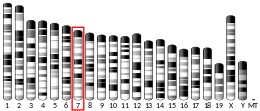OR51E2
OR51E2| OR51E2 | |||||||||||||||||||||||||||||||||||||||||||||||||||
|---|---|---|---|---|---|---|---|---|---|---|---|---|---|---|---|---|---|---|---|---|---|---|---|---|---|---|---|---|---|---|---|---|---|---|---|---|---|---|---|---|---|---|---|---|---|---|---|---|---|---|---|
| 식별자 | |||||||||||||||||||||||||||||||||||||||||||||||||||
| 별칭 | OR51E2, OR51E3P, OR52A2, PSGR, 후각 수용체 패밀리 51 서브 패밀리 E 멤버 2, HPRAJ | ||||||||||||||||||||||||||||||||||||||||||||||||||
| 외부 ID | OMIM : 611268 MGI : 2157548 호몰로 유전자 : 23713 유전자 카드 : OR51E2 | ||||||||||||||||||||||||||||||||||||||||||||||||||
| |||||||||||||||||||||||||||||||||||||||||||||||||||
| |||||||||||||||||||||||||||||||||||||||||||||||||||
| |||||||||||||||||||||||||||||||||||||||||||||||||||
| |||||||||||||||||||||||||||||||||||||||||||||||||||
| |||||||||||||||||||||||||||||||||||||||||||||||||||
| 위키데이터 | |||||||||||||||||||||||||||||||||||||||||||||||||||
| |||||||||||||||||||||||||||||||||||||||||||||||||||
후각 수용체 51E2는 인간에서 OR51E2 [5][6]유전자에 의해 암호화되는 단백질입니다.
후각 수용체는 냄새의 인식을 유발하는 신경 반응을 시작하기 위해 코의 냄새 분자와 상호 작용합니다.후각 수용체 단백질은 단일 코딩 엑손 유전자에서 발생하는 G-단백질 결합 수용체(GPCR)의 큰 계열의 구성원입니다.후각 수용체는 많은 신경전달물질 및 호르몬 수용체와 7-트랜스 막 영역 구조를 공유하며 냄새 신호의 인식 및 G 단백질 매개 전달을 담당합니다.후각 수용체 유전자 계열은 게놈에서 가장 큽니다.이 유기체에 대한 후각 수용체 유전자와 단백질에 할당된 명명법은 [6]다른 유기체와 독립적입니다.
구조.

그것의 구조는 2023년에 결정되었는데, 인간 후각 [7][8][9]수용체의 구조에 대한 최초의 설명이었습니다.
리간드
OR51E2는 비교적 좁게 조정된 후각 수용체로, 관련된 냄새 물질의 [10]비교적 작은 세트에만 반응한다는 것을 의미합니다.
OR51E2는 특히 프로피온산을 [10]포함한 짧은 사슬 [11]지방산에 반응합니다.
참고 항목
레퍼런스
- ^ a b c GRCh38: 앙상블 릴리스 89: ENSG00000167332 - 앙상블, 2017년 5월
- ^ a b c GRCm38: 앙상블 릴리스 89: ENSMUSG000043366 - 앙상블, 2017년 5월
- ^ "Human PubMed Reference:". National Center for Biotechnology Information, U.S. National Library of Medicine.
- ^ "Mouse PubMed Reference:". National Center for Biotechnology Information, U.S. National Library of Medicine.
- ^ Xu LL, Stackhouse BG, Florence K, Zhang W, Shanmugam N, Sesterhenn IA, et al. (December 2000). "PSGR, a novel prostate-specific gene with homology to a G protein-coupled receptor, is overexpressed in prostate cancer". Cancer Research. 60 (23): 6568–6572. PMID 11118034.
- ^ a b "Entrez Gene: OR51E2 olfactory receptor, family 51, subfamily E, member 2".
- ^ a b PDB: 8F76; Billesbølle CB, de March CA, van der Velden WJ, Ma N, Tewari J, Del Torrent CL, et al. (March 2023). "Structural basis of odorant recognition by a human odorant receptor". Nature. 615 (7953): 742–749. Bibcode:2023Natur.615..742B. doi:10.1038/s41586-023-05798-y. PMID 36922591. S2CID 254975795.
- ^ Kim SE (2023). "Scientists sniff out the structure of a human olfactory receptor". Chemical & Engineering News. 101 (10): 6. doi:10.1021/cen-10110-scicon3. Retrieved March 31, 2023.
- ^ Parry W (1 May 2023). "How a Human Smell Receptor Works Is Finally Revealed". Quanta Magazine.
- ^ a b Saito H, Chi Q, Zhuang H, Matsunami H, Mainland JD (March 2009). "Odor coding by a Mammalian receptor repertoire". Science Signaling. 2 (60): ra9. doi:10.1126/scisignal.2000016. PMC 2774247. PMID 19261596.
- ^ Pluznick JL, Protzko RJ, Gevorgyan H, Peterlin Z, Sipos A, Han J, et al. (March 2013). "Olfactory receptor responding to gut microbiota-derived signals plays a role in renin secretion and blood pressure regulation". Proceedings of the National Academy of Sciences of the United States of America. 110 (11): 4410–4415. Bibcode:2013PNAS..110.4410P. doi:10.1073/pnas.1215927110. PMC 3600440. PMID 23401498.
진일보한 내용
- Adams MD, Kerlavage AR, Fleischmann RD, Fuldner RA, Bult CJ, Lee NH, et al. (September 1995). "Initial assessment of human gene diversity and expression patterns based upon 83 million nucleotides of cDNA sequence" (PDF). Nature. 377 (6547 Suppl): 3–174. PMID 7566098.
- Xia C, Ma W, Wang F, Liu M (September 2001). "Identification of a prostate-specific G-protein coupled receptor in prostate cancer". Oncogene. 20 (41): 5903–5907. doi:10.1038/sj.onc.1204803. PMID 11593396.
- Yuan TT, Toy P, McClary JA, Lin RJ, Miyamoto NG, Kretschmer PJ (October 2001). "Cloning and genetic characterization of an evolutionarily conserved human olfactory receptor that is differentially expressed across species". Gene. 278 (1–2): 41–51. doi:10.1016/S0378-1119(01)00709-0. PMID 11707321.
- Malnic B, Godfrey PA, Buck LB (February 2004). "The human olfactory receptor gene family". Proceedings of the National Academy of Sciences of the United States of America. 101 (8): 2584–2589. Bibcode:2004PNAS..101.2584M. doi:10.1073/pnas.0307882100. PMC 356993. PMID 14983052.
- Weng J, Wang J, Cai Y, Stafford LJ, Mitchell D, Ittmann M, Liu M (February 2005). "Increased expression of prostate-specific G-protein-coupled receptor in human prostate intraepithelial neoplasia and prostate cancers". International Journal of Cancer. 113 (5): 811–818. doi:10.1002/ijc.20635. PMID 15499628. S2CID 27473061.
- Weng J, Ma W, Mitchell D, Zhang J, Liu M (December 2005). "Regulation of human prostate-specific G-protein coupled receptor, PSGR, by two distinct promoters and growth factors". Journal of Cellular Biochemistry. 96 (5): 1034–1048. doi:10.1002/jcb.20600. PMID 16149059. S2CID 20908653.
- Xu LL, Sun C, Petrovics G, Makarem M, Furusato B, Zhang W, et al. (2006). "Quantitative expression profile of PSGR in prostate cancer". Prostate Cancer and Prostatic Diseases. 9 (1): 56–61. doi:10.1038/sj.pcan.4500836. PMID 16231015.
- Wang J, Weng J, Cai Y, Penland R, Liu M, Ittmann M (June 2006). "The prostate-specific G-protein coupled receptors PSGR and PSGR2 are prostate cancer biomarkers that are complementary to alpha-methylacyl-CoA racemase". The Prostate. 66 (8): 847–857. doi:10.1002/pros.20389. PMID 16491480. S2CID 25548828.
외부 링크
- OR51E2+단백질,+미국 국립 의학 도서관 의학 주제 제목(MeSH)의 인간
이 기사는 공공 영역에 있는 미국 국립 의학 도서관의 텍스트를 통합합니다.







